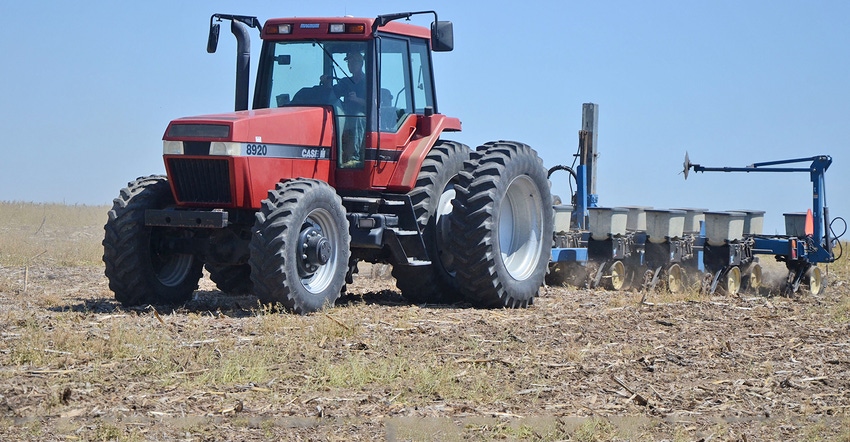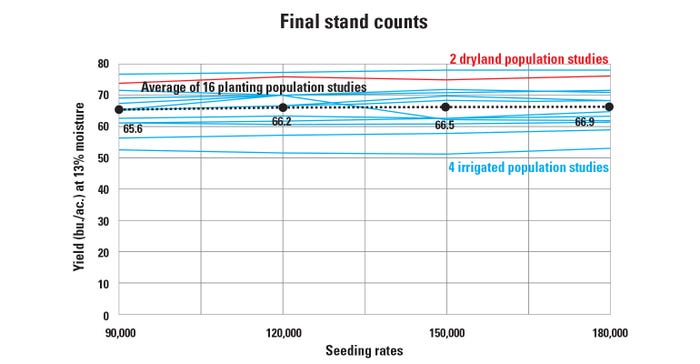March 5, 2018

By Jenny Rees
The question surrounding soybean populations continues to be asked by soybean growers in Nebraska, especially as growers look to reduce input costs. For 11 years, participants in the Nebraska On-Farm Research Network have researched this topic for themselves.
Their findings? Reducing soybean seeding rates from 180,000 or 150,000 seeds per acre to 120,000 seeds per acre doesn’t statistically reduce yields in 30-inch rows in silty clay loam and silt loam soils in south-central and southeastern Nebraska.
Results of 16 studies showed for seeding rates of 180,000, 150,000 and 120,000 seeds per acre, average yields were 66.9, 66.5 and 66.2 bushels per acre, respectively (see table). The early studies within this data set all had seed germination of at least 90% listed on the seed bag. In all but two situations (seeded at 180,000, achieving 88%), the growers were able to achieve 90% or greater of their planted stand.
This data set includes:
• latest soybean varieties in 2006-16
• erect and bushy-type varieties
• higher- and lower-yielding situations
• 14 irrigated fields and two nonirrigated
• hail events occurring from cotyledon stage to R2 in some fields
• crusting in nonirrigated fields.
• some fields with treated seed and others without (determined by grower’s planting date)
• pod and seed count data (shows similar numbers of seeds per acre and ultimately yield per acre)
• increased plant branching at lower seeding rates (difficulty in telling the seeding rate treatments apart as the season progressed)
Narrow rows
Data also exists for 15-inch row soybean in 2016-17 in nonirrigated fields. In a Richardson County field, seeding rates of 116,000, 130,000, 160,000 and 185,000 were planted. There were no statistical yield differences between 185,000, 160,000 and 130,000, with yields of 68, 68, and 67 bushels per acre, respectively.
The 116,000-seeded rate resulted in a yield of 66 bushels per acre. Heavy crusting affected final plant populations in the field ranging from 87,600 to 126,000 and the highest marginal net return was for the 116,000-seeded rate.
For two years seeding rates of 90,000, 120,000, 150,000, and 180,000 were compared in two Washington County fields in 15-inch rows.

Yield results of on-farm seeding rate studies from 2006 to 2010. Average final stands from seeding rates of 90,000 = 83,010 plants per acre (ppa); 120,000 = 106,269 ppa; 150,000 = 132,059 ppa; 180,000 = 156,626 ppa.
In 2016, there were no-significant yield differences of 76, 77, 77 and 76 bushels per acre, respectively, and nonsignificant yield differences of 94, 95, 96 and 96 bushels per acre, respectively, in 2017. In both years, the 90,000-seed-per-acre population resulted in the highest marginal net return, and the grower was able to achieve final plant stands of over 90% of the original seeding rates for all treatments both years.
Recommendations
In the part of the state where I serve, informal surveys have shown most farmers plant between 140,000 to160,000 seeds per acre. So, my recommendation based on our research is to reduce your seeding rate to 120,000 seeds per acre aiming for a final plant stand of 100,000 plants per acre. In other parts of the state, Extension educators are recommending reducing populations from 180,000-plus to 140,000 seeds per acre as an incremental beginning step.
Ultimately, our research data for 11 years shows no statistical yield differences in seeding rates from 120,000 to 180,000 seeds per acre in 15- or 30-inch rows in silty clay loam or clay loam soils. Therefore, reducing seeding rates by 40,000 seeds per acre is a way to consider reducing input costs for 2018 without impacting your yield.
Still hesitant? Consider trying this yourself for your location. Simply compare your current seeding rate versus a reduced rate and see what happens for your field conditions. Protocols can be found at our Nebraska On-Farm Research Network website. You can also download the Nebraska On-farm Research app available in Apple and Android to help you set up your plot design to obtain scientific results.
Please contact your local Extension educator or anyone involved in our Nebraska On-Farm Research Network for additional questions or for help setting up your research project.
Rees is a Nebraska Extension educator.
You May Also Like




